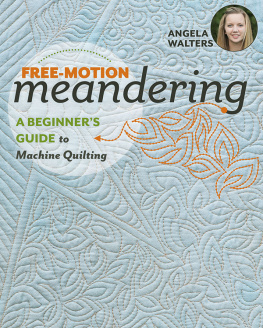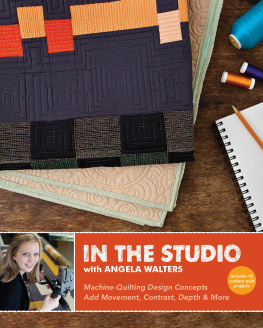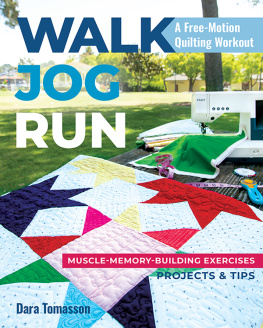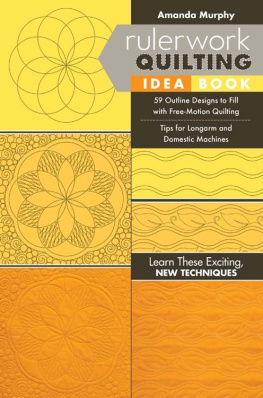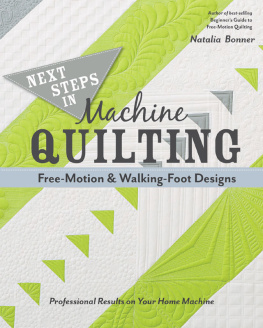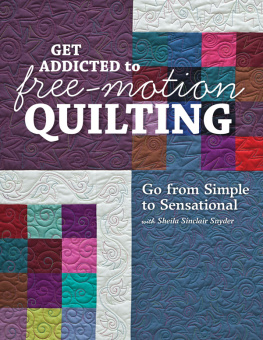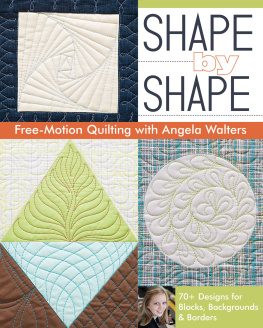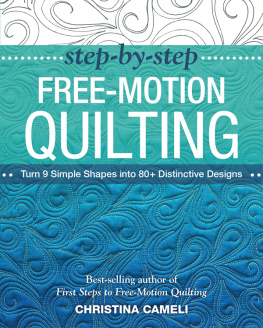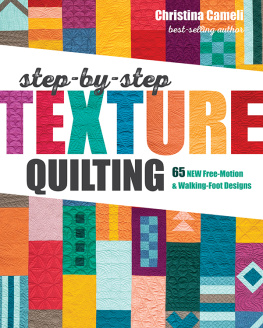Publisher: Amy Marson
Creative Director: Gailen Runge
Editor: Liz Aneloski
Technical Editor: Linda Johnson
Cover/Book Designer: April Mostek
Production Coordinators: Joe Edge and Zinnia Heinzmann
Production Editors: Jeanie German and Alice Mace Nakanishi
Illustrator: Aliza Shalit
Photo Assistant: Mai Yong Vang
Hand Model: Kristi Visser
Style photography by Lucy Glover and
Instructional photography by Diane Pedersen
of C&T Publishing, Inc., unless otherwise noted
Published by C&T Publishing, Inc., P.O. Box 1456, Lafayette, CA 94549

INTRODUCTION
The curse of knowledge is a real thing. Once a skill is learned, it is hard to remember not knowing how to do it. While it may be hard for me to remember what it was like to be a brand new machine quilter, I see it in the faces of my students when I teach machine quilting classes.
Youre sitting at your sewing machine with a quilt top, ready to quilt. You know what you want the quilting to look like, but your hands wont cooperate. Theres no doubt that its a frustrating experience. But, I want to show you that, just like any other skill, it can be learned.
Thats why I wrote this book. I learned machine quilting through trial and error, mostly error. I want to show you that finishing your own quilts isnt as hard as you might think.
Myth of Expertise
It can be tempting to think that there is a correct way to free-motion quilt, but that isnt the case. There are many, many different ways. As I always say, I am not an expert in machine quilting, I am only the expert of my own opinion. In this book, I will share what works for me. Remember though, these are only suggestions. If something doesnt work for you, try something different!
Why Meanders?
A meander is a quilting design that is repeated to fill in an area. Its one of the most versatile designs to learn. A couple of meandering designs in your arsenal are all you need to quilt almost any quilt.
My only goal in this book is to encourage you to not only finish your quilts, but to actually enjoy the process. If you dont believe that its possible, keep reading and I will do my best to convince you.

GETTING STARTEDTHE BASICS
There are so many questions when it comes to machine quilting. Where to start? What to do? With so many options, it can be overwhelming. The most important thing is that you get started! Thats why I am going to walk you through this step by stepalmost as if I were sitting right next to you, drinking a coffee, and cheering you on.
We are not going to go over every option for every step of the process. Sometimes, having too many choices can make it harder to get started. Instead, Im going to share what works for me. Then, as you become more familiar with machine quilting, you can experiment with different notions and tools. Getting started is the most important part of this process.
Tools Needed
Here are the very basic things you need to get started.
GET OFF ON THE RIGHT FOOT
To get started, you need a sewing machine and a free-motion quilting foot. This is the magic tool that makes free-motion quilting possible.
If you arent sure what to use with your machine, check with your machines manufacturer. It may be called a darning foot or hopping foot. There are several different types, just pick one and try it out. As you become more comfortable with free-motion quilting, you can try out different options to see what you prefer.
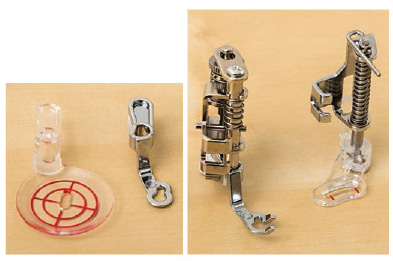
A sampling of free-motion quilting feet
DROP THE FEED DOGS
These guys get a break. Normally they move the fabric through while you sew, but since they pull in just one direction, they arent ideal for free-motion quilting.
If your machine is older or wont let you drop the feed dogs, you can cover them with a Supreme Slider.

Feed dogs dropped
NOTE
You may think that you need a special machine to free-motion quilt your own quilt tops, but that isnt the case. Use the machine and the tools you already have and get started.
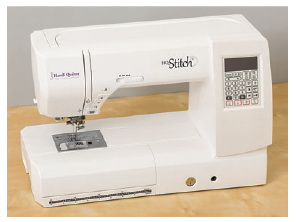
GRAB SOME QUALITY THREAD
When it comes to machine quilting, the thread is so very important. Trust me on this! Thread that works great for piecing wont necessarily work well for machine quilting. Moving the quilt in all different directions at different speeds will put stress on the thread. Using a high-quality thread will help prevent thread breaking and tension issues.
Thread
What does it all mean? Here are a couple of different things to consider when choosing the perfect thread (for you).
TYPE
There are so many different types of thread available. I could spend the rest of the book talking just about thread. (Dont worry, I wont.) The two most common types, polyester and cotton, are best for new machine quilters.
Polyester thread tends to be thinner and stronger than cotton thread. It has low lint and tends to blend into the quilt more than cotton.
Cotton thread tends to be a little thicker than polyester, which means you can see where you are going while quilting. It has a little more lint than poly thread but looks amazing on your quilts.
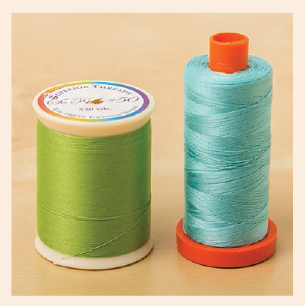
The threads I use the most are So Fine! by Superior Threads (left) and Aurifil cotton (right).
WEIGHT
The weight of a thread refers to how thick it isthe higher the number, the thinner the thread. Which weight you should use depends on how much you want the quilting to show up.
Starting with a 50-weight (or even a 40-weight) is a good option.
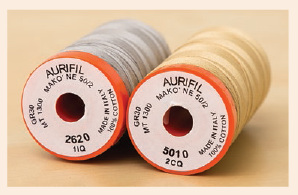
COLOR
This is the fun part; picking out the perfect color thread from the enormous selection availablethere is no wrong answer. Pick what you think looks great.
Although I love a range of fun colors, I tend to use neutrals the most. Off-white, light yellow, gray, and tan are my most commonly used quilting threads. When the thread matches the fabric on the quilt top, it helps keep the quilting from overwhelming the quilt.
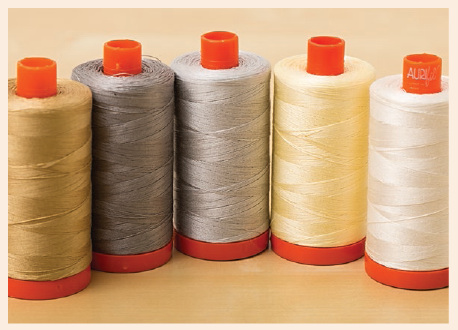
CHOOSE THE BATTING
Choosing the batting is an important part of the quilt-making process. The good thing is that, as long as you choose a quality batting, there is no wrong answer.
Batting
I prefer polyester batting because it has a nice drape and it resists creasing. Cotton batting is also a great option. It has an amazing softness and is perfect for bed quilts. Ultimately, the best option is to try all different kinds of batting and see what you prefer!

Next page
